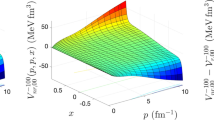Summary
Wave function components containing a single Δ-isobar are included in the calculation of the three-nucleon bound states. The two-nucleon interaction acts in all partial waves up to total angular momentumI=2. The presence of a Δ-isobar increases the three-nucleon binding energy by about 0.3 MeV, 0.6MeV repulsion being a dispersive two-body effect, 0.9 MeV attraction arising from the three-nucleon force with intermediate Δ-isobars. The effect of the Δ on the three-nucleon charge and magnetic form factors is investigated. The possibility of treating the Δ-isobar as a dynamic pion-nucleon system in nuclear structure and nuclear-structure corrections beyond single Δ excitation in the coupled-channel approach are also discussed.
Riassunto
Si includono le componenti della funzione d’onda che contengono un singolo isobaro Δ nel calcolo degli stati legati a tre nucleoni. L’interazione a due nucleoni agisce in tutte le onde parziali fino ad un impulso angolareI=2. La presenza di un isobaro Δ fa aumentare l’energia di legame a tre nucleoni di circa 0.3 MeV, la repulsione a 0.6 MeV essendo un effetto dispersivo a due corpi, e l’attrazione a 0.9 MeV derivando dalla forza a tre nucleoni con isobari Δ intermedi. Si studia l’effetto di Δ sui fattori di forma della carica e magnetici a tre nucleoni. Si discutono la possibilità di trattare l’isobaro Δ come sistema dinamico pione-nucleone nella struttura nucleare e le correzioni alla struttura nucleare al di là della singola eccitazione Δ nell’approccio dei canali accoppiati.
--Резюме
При вычислении связанных состояний трех нуклонов включаются компоненты волновых функций, содержащие Δ-изобару. Двух-нуклонное взаимодействие присутствует во всех парциальных волнах вплоть до моментаI=2. Присутствие Δ-изобары увеличивает энергию связи трех нуклонов на величину 0.3 МэВ, 0.6 МэВ отталкивание представляет дисперсионный двух-частичный эффект, 0.9 МэВ притяжение возникает из трех-нуклонной силы с промежуточными Δ-изобарами. Исследуется влияние Δ на трех-нуклонный зарядовый и магнитный формфакторы. Также обсуждаются возможность рассмотрения Δ-изобары, как динамической пион-нуклонной системы в ядерной структуре, и поправки к ядерной структуре, помимо Δ-возбуждения в подходе связанных каналов.
Similar content being viewed by others
References
Ch. Hajduk andP. U. Sauer:Nucl. Phys. A,369, 321 (1981).
M. Lacombe, B. Loiseau, J. M. Richard, R. Vinh Mau, J. Côté, P. Pirès andR. de Tourreil:Phys. Rev. C,21, 861 (1980).
R. V. Reid:Ann. Phys. (N. Y.),50, 411 (1968).
P. U. Sauer:Nucleon-Nucleon Interactions—1977, edited byD. F. Measday, H. W. Fearing andA. Strathdee (New York N. Y., 1978), p. 195.
I. Sick:Few Body Systems and Electromagnetic Interactions, edited byC. Ciofi degli Atti andE. De Sanctis (Berlin, 1978), p. 299.
R. G. Arnold, B. T. Chertok, S. Rock, W. P. Schütz, Z. M. Szalata, D. Day, J. S. McCarthy, F. Matin, B. A. Mecking, I. Sick andG. Tamas:Phys. Rev. Lett.,40, 1429 (1978), and references therein.
J. M. Cavedon, B. Frois, D. Goutte, M. Huet, Ph. Leconte, J. Martino, X. H. Phan, S. K. Platchkov, S. E. Williamson, W. Boeglin, I. Sick, P. de Witt-Huberts, L. S. Cardmann andC. N. Papanicolas:Phys. Rev. Lett.,49, 986 (1982).
F. Villars:Helv. Phys. Acta,20, 476 (1947).
R. A. Brandenburg, S. A. Coon andP. U. Sauer:Nucl. Phys. A,294, 305 (1978).
D. O. Riska andG. E. Brown:Phys. Lett. B,32, 662 (1970).
H. Meier-Hajduk, Ch. Hajduk, P. U. Sauer andW. Theis:Nucl. Phys. A,395, 332 (1983).
K. Dreissigacker, S. Furui, Ch. Hajduk, P. U. Sauer andR. Machleidt:Nucl. Phys. A,375, 334 (1982).
R. A. Arndt andB. J. VerWest:\({\mathcal{N}}{\mathcal{N}}\) scattering analysis below 850 MeV:a status report (DOE/ER/05223-29 report 1980).
Ch. Hajduk, P. U. Sauer andW. Strueve:Nucl. Phys. A, in press.
J. W. Durso, M. Saarela, G. E. Brown andA. D. Jackson:Nucl. Phys. A,278, 445 (1977).
S. N. Yang:Phys. Rev. C,24, 779 (1981).
W. Strueve, Ch. Hajduk andP. U. Sauer:Nucl. Phys. A, in press.
Author information
Authors and Affiliations
Additional information
Work supported by funds of the Deutsche Forschungsgemeinschaft (DFG) contract Sa 247/3.
Traduzione a cura della Redazione.
Переведено редакцией.
Rights and permissions
About this article
Cite this article
Sauer, P.U. The three-nucleon bound state with isobaric and pionic degrees of freedom. Nuov Cim A 76, 309–321 (1983). https://doi.org/10.1007/BF02833728
Received:
Published:
Issue Date:
DOI: https://doi.org/10.1007/BF02833728



